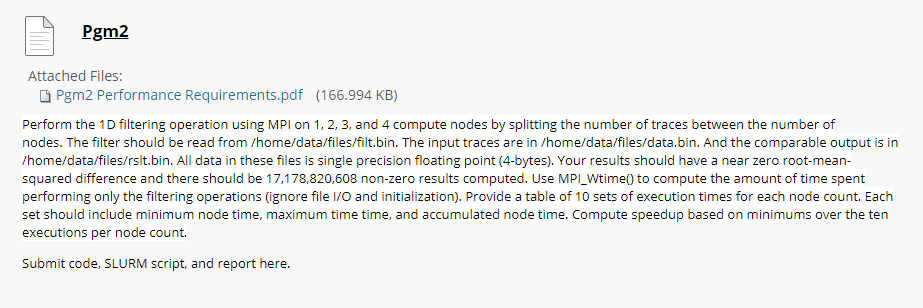

Pgm2 Attached Files: Pgm2 Performance Requirements.pdf (166.994 KB) Perform the 1D filtering operation using MPI on 1, 2, 3, and 4 compute nodes by splitting the number of traces between the number of nodes. The filter should be read from /home/data/files/filt.bin. The input traces are in /home/data/files/data.bin. And the comparable output is in /home/data/files/rsit.bin. All data in these files is single precision floating point (4-bytes). Your results should have a near zero root-mean- squared difference and there should be 17,178,820,608 non-zero results computed. Use MPI_Wtime() to compute the amount of time spent performing only the filtering operations (ignore file I/O and initialization). Provide a table of 10 sets of execution times for each node count. Each set should include minimum node time, maximum time time, and accumulated node time. Compute speedup based on minimums over the ten executions per node count. Submit code, SLURM script, and report here. Nodes Min Actual Limit 0.8 Time 73.5877 36.8926 24.7836 18.585 1.6 2.4 3.2 1.994646623 2.969209477 3.9595211194 Pgm2 Attached Files: Pgm2 Performance Requirements.pdf (166.994 KB) Perform the 1D filtering operation using MPI on 1, 2, 3, and 4 compute nodes by splitting the number of traces between the number of nodes. The filter should be read from /home/data/files/filt.bin. The input traces are in /home/data/files/data.bin. And the comparable output is in /home/data/files/rsit.bin. All data in these files is single precision floating point (4-bytes). Your results should have a near zero root-mean- squared difference and there should be 17,178,820,608 non-zero results computed. Use MPI_Wtime() to compute the amount of time spent performing only the filtering operations (ignore file I/O and initialization). Provide a table of 10 sets of execution times for each node count. Each set should include minimum node time, maximum time time, and accumulated node time. Compute speedup based on minimums over the ten executions per node count. Submit code, SLURM script, and report here. Nodes Min Actual Limit 0.8 Time 73.5877 36.8926 24.7836 18.585 1.6 2.4 3.2 1.994646623 2.969209477 3.9595211194








